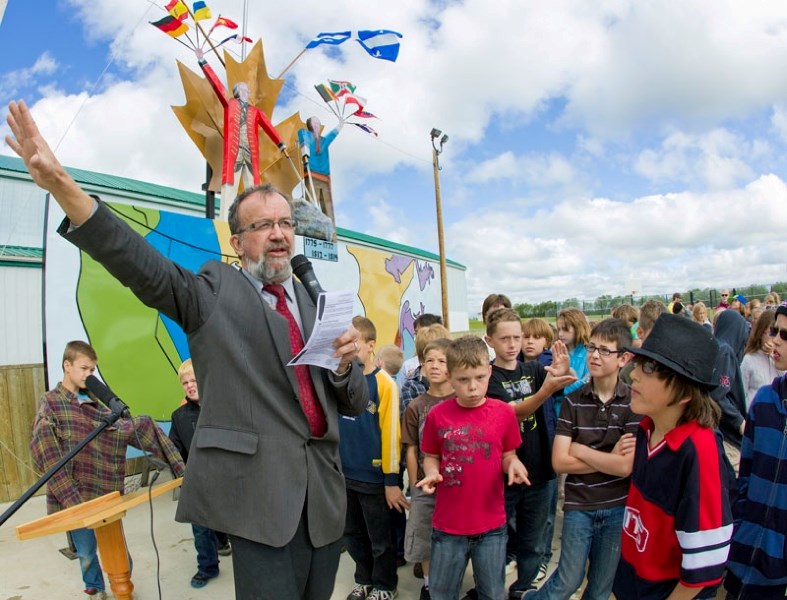Louis Forcade now has an ironclad place in Legal's history.
The 52-year-old welder and lifelong Legal resident had spent hundreds of hours assembling a 2,000-pound steel sculpture to Canadian unity. When it was unveiled before a large group of Legal residents last week, he was pleasantly surprised to find his face on it.
"I took a look at the men [on the monument] and said, hey, that looks like me!" His partners on the projects hadn't told him about this little twist. "I feel myself humbled."
Forcade was part of a small group of Albertans that assembled the house-sized steel monument known as Ensemble-Together, which was revealed to the public in Legal last Friday. The steel sculpture, which cost roughly $30,000, is part of the town's ongoing effort to attract tourism through public art, such as its many murals.
The piece aims to depict the unity between Canada's three founding nations, said sculpture designer and town resident Ernest Chauvet: French, English and aboriginal.
"Why is there French in Canada in the first place? It goes right back to these roots," he said.
A ton of history
Chauvet is a member of the Centralta Tourism Society and one of the organizers of Legal's mural project. This is the first major sculpture to be added to it.
Forcade said he had previously welded frames for some of the town's murals, and was asked by Chauvet to help with this project. "It was a lot of work," he said, and took about 200 hours to finish.
Chauvet asked Red Deer artist John Ellenberger to paint the piece. Ellenberger, who has painted murals, cars, bikes and taxidermied fish for 30 years, said he met Chauvet at a conference in Ontario.
"I've done a few water towers, but nothing like this," he said, adding that the toughest part was getting the Gumby-esque figures atop the sculpture to look lifelike, he said.
The sculpture is made from 16-gauge mild steel plate, Forcade said, and weighs about a ton. It's about six metres by 11 metres, and is currently located by the town's arena.
The sculpture features a large multicoloured map of Canada, atop of which stand two life-sized figures, one dressed as a British soldier, the other as a French-Canadian, with a rock between them. The figures hold swords, the tips of which extend toward an arrow embedded in the rock, and fly flags of many nations from their outstretched fingers. They stand before a large golden maple leaf and the British, Quebec and Canadian flags.
The British figure is Guy Carleton, Chauvet said, who won the loyalty of many French Canadians with the Quebec Act. The arrow represents the First Nations, and was placed at the centre of the piece to reflect their importance. The other figure represents all French-Canadians.
When it came time to paint a face on it, Ellenberger suggested they use Forcade's as a gag.
"We just thought it would be nice for him to be recognized," he said.
When asked how he felt about representing all francophone Canadians, Forcade said he found the idea to be "kind of hilarious."
Message of unity
The two dates beneath the rock — 1775-1777 and 1812-1814 — denote two wars that brought Canada together, Chauvet said. The Americans invaded what is now Canada in both, only to be repelled by British, French and aboriginal soldiers. "That co-operative effort is why Canada is bilingual."
This spirit of co-operation forms the roots of the Canadian identity, Chauvet said, and of the inclusive nature of the country today. The sculpture is meant to show how members of all nations have come together to create Canada.
Everyone says there's no unity in Canada, Ellenberger says, but there is. "People just have to give up their hates."
The sculpture will move to its permanent home on the west side of town as soon as the ground dries out, Chauvet said.




